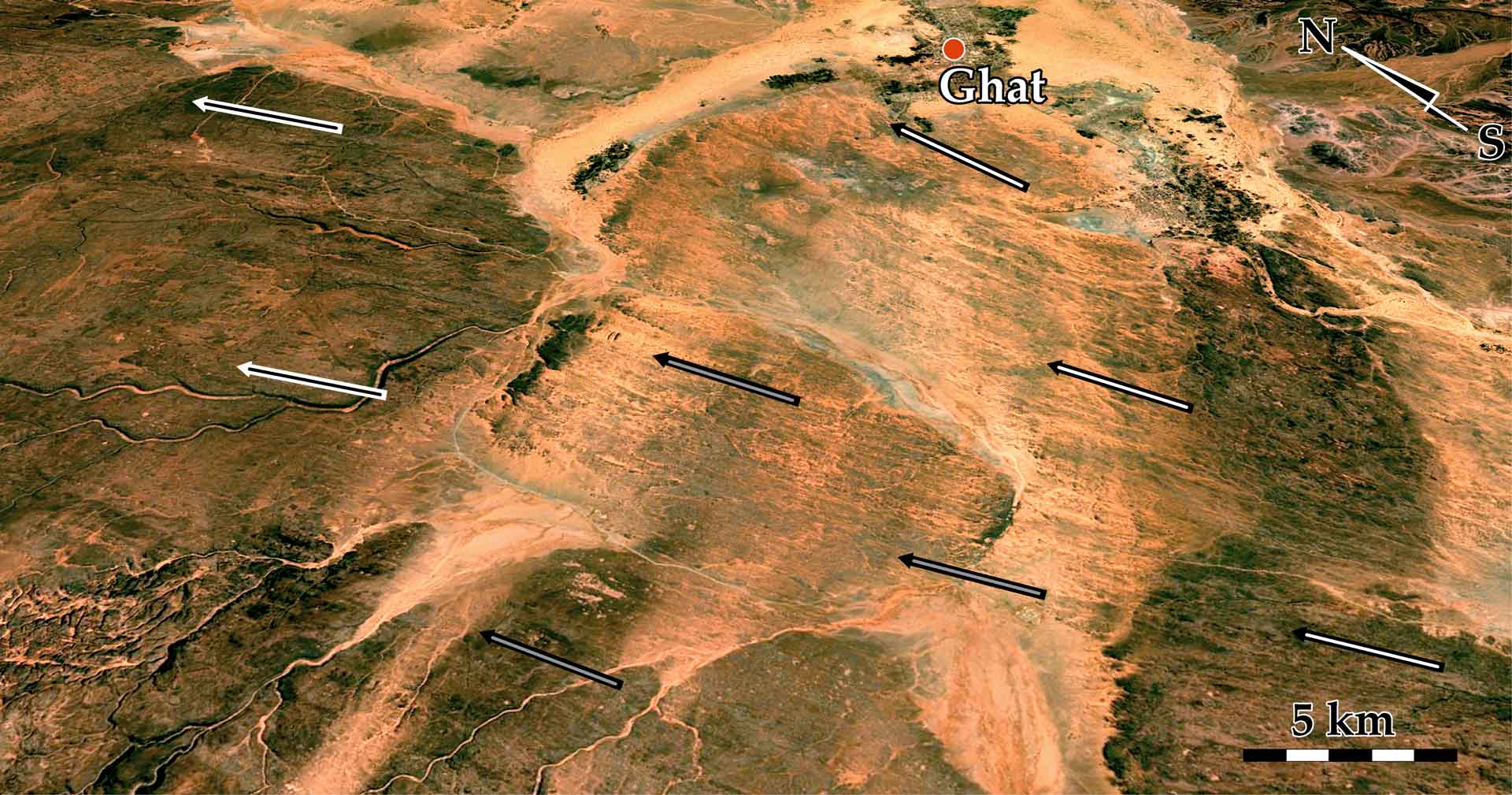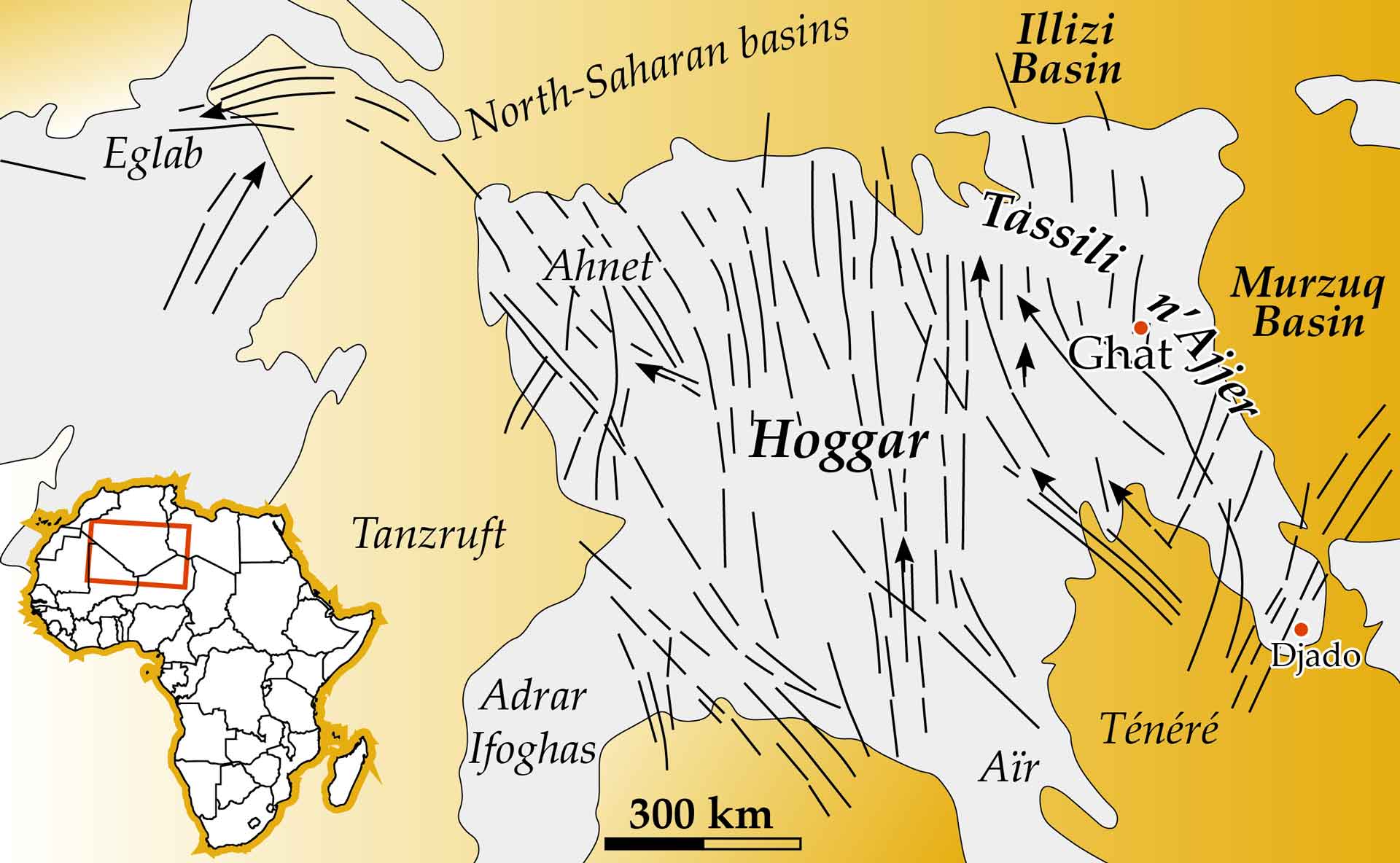The Ordovician glacial pavements of the Tassili n’Ajjer
Algeria and Lybia

A glacial pavement emerging from the Saharan sands, close to the Algeria-Libya border. It exhibits parallel striae and grooves (ice flowed away from the observer).
Geological Period
Upper Ordovician
Main geological interest
Stratigraphy and sedimentology
History of geosciences
Location
Central Sahara,
Algeria and Lybia
24°55’00”N, 010°04’00”E
A glacial pavement emerging from the Saharan sands, close to the Algeria-Libya border. It exhibits parallel striae and grooves (ice flowed away from the observer).
Spectacular glacial erosion surfaces that allow a glimpse of the end-Ordovician ice streams that once crossed the entire Sahara.
At the end of the Ordovician, glaciers repeatedly extended over South America, Africa and the Middle East. Meltwater channels, striated pebbles, glaciotectonic fold-and-thrust belts and few tillites have been left behind but the best evidence for an early Paleozoic Ice Age is the stratigraphic superimposition of glacial pavements. Recognized from space to field scale, impressive exhumed erosion surfaces are preserved from Mauritania to Chad (Ghienne et al., 2023). In Africa, subsidiary indices occur in Morocco, Ethiopia and South Africa. Together, they highlight past continental-scale ice sheets, which, as in Antarctica today, were drained by ice streams.
- Geological description
The Tassili n’Ajjer is an extensive sandstone plateau gently plunging northeastward into the Illizi (Algeria) and Murzuq (Libya) basins. In its western part wadis have deeply dissected the plateau, and to the east Cenozoic erosion has beautifully exposed stratal surfaces corresponding to paleo-landscapes. From 26°30’N, glacial pavements are identified along the Algerian-Libyan border, as far south as Djado in northern Niger (~700 km). Several surfaces are demonstratively exposed west and south of the town of Ghat, where they constitute 1-10 km-scale corrugations superimposed by subglacial streamlined bedforms best identified on satellite imagery (Moreau et al., 2005). Shear bands are observed in outcrop. They developed in soft sediments —mainly sand—, the substrate of the Ordovician glaciers. Striated and grooved surfaces formed either as intraformational shear planes within the subglacial sand, and/or at the ice-sand interface. Sheath folds, sigmoidal fabrics, fluid-escape structures, hydro-schistosity and extensional step fractures (Riedel shears) are additional features linked to subglacial shearing that related to complex sequences of superimposed stages of deformation (Denis et al., 2010). Deformation processes and glacial geomorphology allow us to interpret these streamlined bedforms as the imprints of Ordovician ice streams (Deschamps et al., 2013; Le Heron et al., 2022).
- Scientific research and tradition
In the 1960s, a glacial origin was recognized for the Ordovician record throughout the Sahara. Around the Hoggar, the wide distribution of pavements was mapped, promoting the idea of African ice sheets (Beuf et al., 1971). Recently, studies have clarified the chronology and highlighted ice streams, allowing comparison between Paleozoic and Cenozoic glaciations.
- Reference
Beuf, S. et al. (1971) Les gres du paleozoique inferieur au sahara : sedimentation et discontinuites, évolution stucturale d’un craton. Paris: Technip (Science et Technique du Petrole, 18).
Denis, M. et al. (2010) ‘Subglacial deformation and water-pressure cycles as a key for understanding ice stream dynamics: evidence from the Late Ordovician succession of the Djado Basin (Niger)’, International Journal of Earth Sciences, 99(6), pp. 1399–1425. Available at: https://doi.org/10.1007/s00531-009-0455-z.
Deschamps, R., Eschard, R. and Roussé, S. (2013) ‘Architecture of Late Ordovician glacial valleys in the Tassili N’Ajjer area (Algeria)’, Sedimentary Geology, 289, pp. 124–147. Available at: https://doi.org/10.1016/j.sedgeo.2013.02.012.
Ghienne, J.-F. et al. (2023) ‘The Ordovician record of North and West Africa: unravelling sea-level variations, Gondwana tectonics, and the glacial impact’, Geological Society of London Special Publications, 533, pp. SP533-2022–213. Available at: https://doi.org/10.1144/SP533-2022-213.
Le Heron, D.P. et al. (2022) ‘New Perspectives on Glacial Geomorphology in Earth’s Deep Time Record’, Frontiers in Earth Science, 10, p. 870359. Available at: https://doi.org/10.3389/feart.2022.870359.
Moreau, J. et al. (2005) ‘440 Ma ice stream in North Africa’, Geology, 33(9), pp. 753–756. Available at: https://doi.org/10.1130/G21782.1.
- Author(s)
Ghienne Jean-François.
Institut Terre et Environnement de Strasbourg, France.
Abdallah Hussein.
Alicante, Spain.
Buoncristiani Jean-François.
Biogéosciences, Université de Bourgogne, France.
Deschamps Rémi.
IFPEN, Rueil-Malmaison, France.
Le Heron Daniel.
Department of Geology, Universität Wien, Austria.
Moreau Julien.
NW Edge, Isle of Lewis, HS2 9AJ United Kingdom.


